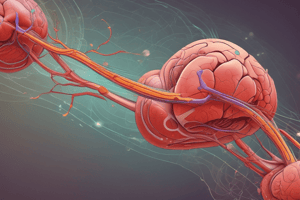Podcast
Questions and Answers
What is the primary function of the glomerulus in the kidney?
What is the primary function of the glomerulus in the kidney?
- Production of urine
- Reabsorption of water and nutrients
- Secretion of waste products
- Filtration of blood (correct)
Which of the following is NOT a function of the kidneys?
Which of the following is NOT a function of the kidneys?
- Maintenance of strong bones
- Regulation of body temperature (correct)
- Regulation of blood pressure
- Production of red blood cells
What is the name of the tube where reabsorption of nutrients and water takes place?
What is the name of the tube where reabsorption of nutrients and water takes place?
- Bowman's capsule
- Loop of Henle
- Distal convoluted tubule
- Proximal convoluted tubule (correct)
Which structure in the nephron is responsible for collecting urine and transporting it to the renal pelvis?
Which structure in the nephron is responsible for collecting urine and transporting it to the renal pelvis?
What is the approximate percentage of total blood volume that the kidneys receive?
What is the approximate percentage of total blood volume that the kidneys receive?
Which of the following statements accurately describes the process of urine formation?
Which of the following statements accurately describes the process of urine formation?
How many nephrons are estimated to be present in each kidney?
How many nephrons are estimated to be present in each kidney?
Which of the following is NOT a component of a nephron?
Which of the following is NOT a component of a nephron?
Flashcards are hidden until you start studying
Study Notes
Structure
- The kidneys are two bean-shaped organs located in the lower back on either side of the spine
- Each kidney is about 4-5 inches long and 2-3 inches wide
- The kidneys are protected by the rib cage and are surrounded by a layer of fat
Functions
- Filtration: Kidneys filter waste and excess fluids from the blood
- Regulation of electrolytes: Kidneys regulate levels of electrolytes such as sodium, potassium, and calcium
- Regulation of acid-base balance: Kidneys help maintain the body's acid-base balance by regulating the levels of acid and base in the blood
- Production of hormones: Kidneys produce hormones that help regulate blood pressure, produce red blood cells, and maintain strong bones
- Waste removal: Kidneys remove waste products from the blood and excrete them in the urine
Nephrons
- The functional units of the kidney are called nephrons
- Each kidney contains about 1 million nephrons
- Nephrons consist of:
- Glomerulus: a cluster of capillaries that filter the blood
- ** Bowman's capsule**: a double-layered sac that surrounds the glomerulus
- Proximal convoluted tubule: a tube where reabsorption of nutrients and water takes place
- Loop of Henle: a U-shaped tube where further reabsorption and secretion occur
- Distal convoluted tubule: a tube where final reabsorption and secretion occur
- Collecting duct: a tube that collects urine and transports it to the renal pelvis
Blood Supply
- Kidneys receive about 20-25% of the total blood volume
- Blood enters the kidney through the renal artery and leaves through the renal vein
Urine Formation
- The process of urine formation involves:
- Filtration: blood is filtered in the glomerulus
- Reabsorption: nutrients and water are reabsorbed in the proximal convoluted tubule
- Secretion: waste products are secreted into the tubule
- Urine concentration: urine is concentrated in the loop of Henle and distal convoluted tubule
- Urine collection: urine is collected in the renal pelvis and transported to the bladder through the ureters
Kidney Structure
- Kidneys are located in the lower back on either side of the spine
- Each kidney is approximately 4-5 inches long and 2-3 inches wide
- Kidneys are protected by the rib cage and surrounded by a layer of fat
Kidney Functions
- Filter waste and excess fluids from the blood
- Regulate levels of electrolytes such as sodium, potassium, and calcium
- Maintain the body's acid-base balance by regulating acid and base levels in the blood
- Produce hormones that regulate blood pressure, produce red blood cells, and maintain strong bones
- Remove waste products from the blood and excrete them in the urine
Nephrons
- Functional units of the kidney
- Each kidney contains approximately 1 million nephrons
- Nephrons consist of:
- Glomerulus: a cluster of capillaries that filter the blood
- Bowman's capsule: a double-layered sac that surrounds the glomerulus
- Proximal convoluted tubule: a tube where reabsorption of nutrients and water takes place
- Loop of Henle: a U-shaped tube where further reabsorption and secretion occur
- Distal convoluted tubule: a tube where final reabsorption and secretion occur
- Collecting duct: a tube that collects urine and transports it to the renal pelvis
Blood Supply
- Kidneys receive approximately 20-25% of the total blood volume
- Blood enters the kidney through the renal artery and leaves through the renal vein
Urine Formation
- Involves filtration, reabsorption, secretion, urine concentration, and urine collection
- Blood is filtered in the glomerulus
- Nutrients and water are reabsorbed in the proximal convoluted tubule
- Waste products are secreted into the tubule
- Urine is concentrated in the loop of Henle and distal convoluted tubule
- Urine is collected in the renal pelvis and transported to the bladder through the ureters
Studying That Suits You
Use AI to generate personalized quizzes and flashcards to suit your learning preferences.


